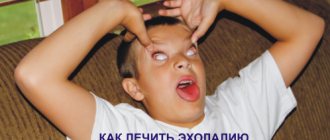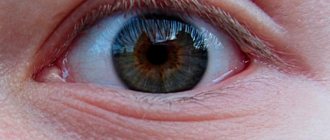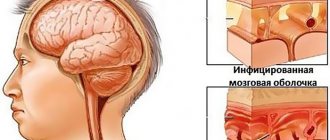Motor speech area of the cerebral cortex, Broca's area
The motor speech area is an area of the cerebral cortex located in the posterior
section of the inferior frontal gyrus of the dominant hemisphere anterior to the cortical centers of movements of the lips, larynx, and tongue. When the motor speech area is damaged, motor alalia or motor aphasia occurs (motor alalia or motor aphasia syndrome).
Sensory speech area of the cerebral cortex, Wernicke's center
The sensory speech area of the cerebral cortex is an area of the cerebral cortex in the posterior part of the superior temporal gyrus of the dominant hemisphere. The term "sensory" comes from the Latin word "sensus", which means "feeling, perception, sensation". A synonym for the sensory speech area is Wernicke's center, Wernicke's area. When the sensory speech area is damaged, sensory alalia syndrome or sensory aphasia occurs.
When the sensory and motor areas of the cerebral cortex are damaged, sensorimotor alalia or sensorimotor aphasia occurs simultaneously.
Delayed speech development - symptoms and treatment
Classes with a speech therapist. The speech therapist conducts special lessons with the child on the initiation and development of speech, and helps to construct sentences correctly. Such techniques include articulatory gymnastics, sound production exercises, and play techniques, such as finger puppet theater. If a child understands phrases, his intelligence is preserved, and his speech is delayed by six months to a year, then speech therapy classes are sufficient [1][8].
Classes with a speech pathologist-defectologist differ from regular speech therapy classes. For example, a speech pathologist is able to work with children who have difficulty understanding speech and severe developmental delays. During classes, the child learns basic concepts (big/small, color, shape, size), does exercises to improve fine motor skills, and learns the names of objects to form a passive vocabulary. After mastering basic knowledge, the speech therapist-defectologist begins to develop expressive speech [7][12][15].
Comprehensive medical and pedagogical rehabilitation for delayed psycho-speech development. If a child does not understand speech well, is excitable, and has not developed social and everyday skills, then comprehensive rehabilitation may be required. In such cases, speech significantly lags behind the age norm, diction is grossly impaired, and other neurological symptoms are expressed [2]. To develop speech, neurologists prescribe nootropic drugs: Cortexin, Cogitum, Ceraxon. According to the manufacturers, the drugs activate neurons, improve the transmission of nerve impulses and eliminate the effects of hypoxia - lack of oxygen. (The effectiveness of these drugs for delayed speech development has not been proven in studies, and in the new Russian clinical guidelines for the treatment of autism, a group of experts has already described nootropics as an ineffective method of treating the disorder - editor's note at ProBolesny). B vitamins will also help normalize the functioning of the nervous system. However, it is important to remember that only a pediatric neurologist prescribes medications, taking into account the characteristics of the child, since medications can cause overexcitation and allergic reactions [2][16].
Microcurrent reflexology is a method of treating children with speech delays, approved and recommended by the Ministry of Health of the Russian Federation. It consists of selective activation of speech areas of the brain:
- Wernicke's area (responsible for speech understanding);
- Broca's area (associated with active vocabulary and the desire to talk);
In addition, influencing the frontal lobes will help develop logical thinking and form everyday skills. Treatment is carried out under the control of electroencephalography (EEG) [6][13][14].
Speech therapy massage is an effect on articulatory muscles: muscles of the face, tongue, lips, soft palate. Manipulations are carried out with sterile probes. The purpose of the massage is to normalize the tone of the muscles of the tongue, orbicularis oris muscle, and improve blood supply to the organs of articulation. The method is necessary for children with excessive drooling and impaired diction. The procedure is also prescribed to non-speaking patients, since speech may be absent due to inability to control the organs of articulation [10][13].
Treatment of damage to speech zones in Saratov, how to improve the functioning of speech zones
Sarklinik provides comprehensive conservative treatment of the speech areas of the cerebral cortex in children (boys and girls), adolescents (boys and girls), adults (men and women) in Saratov, Russia. At the first appointment, the doctor will tell you what reflex massage of speech zones is, what new advanced methods exist for restoring speech disorders; how to treat pathology of the motor and sensory speech zones, how to restore and improve speech. What happens when a pulsed magnetic field is applied to the speech centers in the cerebral cortex in Russia, does this technique always help? What new methods exist for stimulating speech centers that give 95% results? How to really improve the work of the Wernicke center, how to activate the Wernicke area? What is Broca's center? How to increase a child’s vocabulary in Russia? How to improve the impressive (sensory) and expressive (motor) speech of infants, preschoolers, and schoolchildren? Where to treat mental retardation, and what to do if speech zones are disrupted, how to treat speech disorders in Saratov . On the sarclinics website you can ask the doctor a question online and read reviews about the treatment of children.
Anatomical and physiological mechanisms of speech
Knowledge of the anatomical and physiological mechanisms of speech, i.e. structure and functional organization of speech activity, allows us to imagine the complex mechanism of speech. The speech act is carried out by a complex system of organs, in which the main, leading role belongs to the activity of the brain.
The structure of the speech apparatus.
The speech apparatus consists of two closely interconnected parts: the central (regulating) speech apparatus and the peripheral (performing) speech apparatus.
1. The central speech apparatus is located in the brain. It consists of: - cerebral cortex (mainly the left hemisphere) - subcortical nodes - pathways - nuclei of the brainstem (primarily the medulla oblongata) - nerves going to the respiratory, vocal and articulatory muscles.
What is the function of the central speech apparatus and its departments??
Speech, like other manifestations of higher nervous activity, develops at the basis of reflexes. Speech reflexes are associated with the activity of various parts of the brain. However, some parts of the cerebral cortex are of primary importance in the formation of speech. These are the frontal, temporal, parietal and occipital lobes, predominantly of the left hemisphere of the brain (in left-handers, the right).
— The frontal gyri (inferior) are the motor area and are involved in the formation of one’s own oral speech (Broca’s area).
— The temporal gyri (superior) are the speech-auditory area where sound stimuli arrive (Wernicke's center). Thanks to this, the process of perceiving someone else’s speech is carried out.
The parietal lobe of the cerebral cortex is important for understanding speech .
— The occipital lobe is a visual area and ensures the assimilation of written speech (the perception of letter images when reading and writing).
— The subcortical nuclei control the rhythm, tempo and expressiveness of speech.
— The pathways connect the cerebral cortex with the muscles that regulate the activity of the speech apparatus - centrifugal (motor) nerve pathways . The centrifugal pathway begins in the cerebral cortex in Broca's center.
From the periphery to the center, i.e. from the area of the speech organs to the cerebral cortex, there are centripetal pathways . The centripetal pathway begins in the proprioceptors and baroreceptors.
Proprioceptors are found inside muscles, tendons and on the articular surfaces of moving organs. Proprioceptors are excited by muscle contractions. Thanks to proprioceptors, all our muscle activity is controlled.
Baroreceptors are excited by changes in pressure on them and are located in the pharynx. When we speak, proprio- and baroreceptors are irritated, which follows a centripetal path to the cerebral cortex.
The centripetal path plays the role of a general regulator of all activities of the speech organs.
The cranial nerves originate in the nuclei of the brainstem All organs of the peripheral speech apparatus are innervated (innervation is the provision of any organ or tissue with nerve fibers, cells) by cranial nerves . The main ones are: trigeminal, facial, glossopharyngeal, vagus, accessory and sublingual.
— The trigeminal nerve innervates the muscles that move the lower jaw;
- Facial nerve - facial muscles, including muscles that move the lips, puff out and retract the cheeks;
- Glossopharyngeal and vagus nerves - muscles of the larynx and vocal folds, pharynx and soft palate. In addition, the glossopharyngeal nerve is the sensory nerve of the tongue, and the vagus nerve innervates the muscles of the respiratory and cardiac organs.
— The accessory nerve innervates the muscles of the neck, and the hypoglossal nerve supplies the muscles of the tongue with motor nerves and gives it the possibility of a variety of movements.
Through this system of cranial nerves, nerve impulses are transmitted from the central speech apparatus to the peripheral one. Nerve impulses move the speech organs.
But this path from the central speech apparatus to the peripheral one constitutes only one part of the speech mechanism. Another part of it is feedback - from the periphery to the center.
2. The peripheral speech apparatus consists of three sections: 1. Respiratory 2. Vocal 3. Articulatory (sound-producing)
The respiratory section includes the chest with lungs, bronchi and trachea .
Producing speech is closely related to breathing. Speech is formed during the exhalation phase. During the process of exhalation, the air stream simultaneously performs voice-forming and articulatory functions (in addition to another, main one - gas exchange). Breathing during speech is significantly different from usual when a person is silent. Exhalation is much longer than inhalation (while outside of speech, the duration of inhalation is approximately the same). In addition, at the time of speech, the number of respiratory movements is half as much as during normal (without speech) breathing.
It is clear that for a longer exhalation a larger supply of air is needed. Therefore, at the moment of speaking, the volume of inhaled and exhaled air increases significantly (about 3 times). The inhalation during speech becomes shorter and deeper. Another feature of speech breathing is that exhalation at the moment of speech is carried out with the active participation of the exhaled muscles (the abdominal wall and internal intercostal muscles). This ensures its greatest duration and depth, and in addition, increases the pressure of the air stream, without which sonorous speech is impossible.
The vocal section consists of the larynx with the vocal folds located in it. The larynx is a wide, short tube consisting of cartilage and soft tissue. It is located in the front of the neck and can be felt through the skin from the front and sides, especially in thin people.
From above the larynx passes into the pharynx . From below it passes into the trachea . At the border of the larynx and pharynx is the epiglottis . It consists of cartilage tissue shaped like a tongue or petal. Its front surface faces the tongue, and its back surface faces the larynx. The epiglottis serves as a valve: descending during the swallowing movement, it closes the entrance to the larynx and protects its cavity from food and saliva.
In men, the larynx is larger, and the vocal folds are longer and thicker than in women. The length of the vocal folds in women is on average 18-20 mm, in men it ranges from 20 to 24 mm.
How is voice formation or phonation accomplished?
The mechanism of voice formation is as follows. During phonation, the vocal folds are in a closed state (Figure 2). A stream of exhaled air, breaking through the closed vocal folds, somewhat pushes them apart. Due to their elasticity, as well as under the action of the laryngeal muscles, which narrow the glottis, the vocal folds return to their original state, i.e. middle position, so that as a result of the continued pressure of the exhaled air stream, it moves apart again, etc. Closing and opening continues until the pressure of the voice-forming exhalatory stream stops. Thus, during phonation, vibrations of the vocal folds occur. These vibrations occur in the transverse and not the longitudinal direction, i.e. the vocal folds move inward and outward, rather than upward and downward. As a result of vibrations of the vocal folds, the movement of the stream of exhaled air turns over the vocal folds into vibrations of air particles. These vibrations are transmitted to the environment and are perceived by us as vocal sounds. When whispering, the vocal folds do not close along their entire length: in the back part between them there remains a gap in the shape of a small equilateral triangle, through which the exhaled stream of air passes. The vocal folds do not vibrate, but the friction of the air stream against the edges of the small triangular slit causes noise, which we perceive as a whisper. The voice has strength, height, timbre. The strength of the voice depends mainly on the amplitude (span) of vibrations of the vocal folds, which is determined by the amount of air pressure, i.e. exhalation force. The resonator cavities of the extension pipe (pharynx, oral cavity, nasal cavity), which are sound amplifiers, have a significant influence on the strength of the voice. The size and shape of the resonator cavities, as well as the structural features of the larynx, affect the individual “color” of the voice, or timbre . It is thanks to timbre that we distinguish people by their voices. The pitch of the voice depends on the frequency of vibration of the vocal folds, and this in turn depends on the length, thickness and degree of tension. The longer the vocal folds, the thicker they are and the less tense they are, the lower the sound of the voice. In addition, the pitch of the voice depends on the pressure of the air stream on the vocal folds and the degree of their tension.
Articulation department . The main organs of articulation are: - tongue - lips - jaws (upper and lower) - hard palate - soft palate - alveoli Of these, the tongue, lips, soft palate and lower jaw are movable, the rest are fixed (Fig. 3).
The main organ of articulation is the tongue.
The tongue is a massive muscular organ. When the jaws are closed, it fills almost the entire oral cavity. The front part of the tongue is mobile, the back part is fixed and is called the root of the tongue. The movable part of the tongue is divided into: tip, anterior edge (blade), lateral edges and back. The complex plexus of the muscles of the tongue and the variety of their attachment points provide the ability to change the shape, position and degree of position of the tongue within a wide range. This is very important because... the tongue is involved in the formation of vowels and almost all consonant sounds (except labials).
An important role in the formation of speech sounds also belongs to the lower jaw, lips, teeth, hard and soft palates, and alveoli. Articulation consists in the fact that the listed organs form slits, or closures, that occur when the tongue approaches or touches the palate, alveoli, teeth, as well as when the lips are compressed or pressed against the teeth. The volume and clarity of speech sounds are created thanks to resonators. Resonators are located throughout the extension pipe.
The extension tube is everything that is located above the larynx: the pharynx, oral cavity and nasal cavity.
In humans, the mouth and pharynx have one cavity. This creates the possibility of pronouncing a variety of sounds. In animals (for example, a monkey), the cavities of the pharynx and mouth are connected by a very narrow gap. In humans, the pharynx and mouth form a common tube - the extension tube. It performs the important function of a speech resonator. The extension pipe in humans was formed as a result of evolution.
Due to its structure, the extension pipe can change in shape and volume. For example, the pharynx can be elongated and compressed and, conversely, very stretched. Changes in the shape and volume of the extension pipe are of great importance for the formation of speech sounds. These changes in the shape and volume of the extension pipe create the phenomenon of resonance. As a result of resonance, some overtones of speech sounds are enhanced, while others are muffled. Thus, a specific speech timbre of sounds arises. For example, when the sound a occurs, the oral cavity expands, and the pharynx narrows and stretches. And when pronouncing a sound and vice versa, the oral cavity contracts and the pharynx expands.
The larynx alone does not create a specific speech sound; it is formed not only in the larynx, but also in resonators (pharyngeal, oral and nasal). When producing speech sounds, the extension pipe performs a dual function: a resonator and a noise vibrator (the function of a sound vibrator is performed by the vocal folds, which are located in the larynx). The noise vibrator is the gaps between the lips, between the tongue and teeth, between the tongue and the hard palate, between the tongue and the alveoli, between the lips and teeth, as well as the closures between these organs broken by a stream of air.
Using a noise vibrator, voiceless consonants are formed. When the tone vibrator is turned on simultaneously (vibration of the vocal folds), voiced and sonorant consonants are formed.
The oral cavity and pharynx take part in the pronunciation of all sounds of the Russian language. If a person has correct pronunciation, then the nasal resonator is involved only in pronouncing the sounds m and n and soft variants. When pronouncing other sounds, the velum palatine, formed by the soft palate and a small uvula, closes the entrance to the nasal cavity.
So, the first section of the peripheral speech apparatus serves to supply air, the second - to form the voice, the third is a resonator that gives the sound strength and color and, thus, the characteristic sounds of our speech, arising as a result of the activity of individual active organs of the articulatory apparatus.
In order for words to be pronounced in accordance with the intended information, commands are selected in the cerebral cortex to organize speech movements. These commands are called articulation programs . The articulatory program is implemented in the executive part of the speech motor analyzer - in the respiratory, phonation and resonator systems.
Speech movements are carried out so precisely that as a result, certain speech sounds arise and oral (or expressive) speech is formed.
UNDERSTANDING ABOUT FEEDBACK COMMUNICATION . We said above that nerve impulses coming from the central speech apparatus set the organs of the peripheral speech apparatus in motion. But there is also feedback.
How is it carried out?
This connection functions in two directions: the kinesthetic pathway and the auditory pathway.
For the correct implementation of a speech act, control is necessary: 1. with the help of hearing; 2. through kinesthetic sensations.
In this case, a particularly important role belongs to kinesthetic sensations going to the cerebral cortex from the speech organs. It is kinesthetic control that allows you to prevent an error and make a correction before the sound is pronounced.
Auditory control operates only at the moment of pronouncing a sound. Thanks to sound monitoring, a person notices an error. To eliminate the error, you need to correct the articulation and control it.
Return impulses go from the speech organs to the center, where they control the position of the speech organs at which the error occurred. An impulse is then sent from the center, which causes precise articulation. And again the opposite impulse arises - about the achieved result. This continues until articulation and auditory control are matched. We can say that feedback functions as if in a ring - impulses go from the center to the periphery and then from the periphery to the center.
This is how feedback is provided and a second signaling system . An important role here belongs to systems of temporary neural connections - dynamic stereotypes that arise due to repeated perception of language elements (phonetic, lexical and grammatical) and pronunciation. The feedback system ensures automatic regulation of the functioning of the speech organs.
Treatment of speechopathy in Saratov, how to treat speechopathy in Russia
Sarklinik provides speech therapy treatment in Saratov , treatment of speech pathologies, speech disorders in children, boys, girls, teenagers in Russia. Sarklinik knows how to treat logopathies, how to cure logopathies, how to get rid of logopathies.
Treatment of alalia, treatment of aphasia, treatment of stuttering, treatment of speech delay, treatment of speech development disorder.
Sign up for a consultation. There are contraindications. Specialist consultation is required.
Photo: (©) Bioraven | Dreamstime.com\Dreamstock.ru
Related posts:
Why does a child stand on tiptoes, toes, poorly on his legs, not worth it: what to do, how to treat, stand
Where and how to buy an enuresis, urinary alarm clock?
Children's nocturnal enuresis: treatment, causes, how to treat in Russia, Saratov
New in the treatment of Tourette syndrome in Russia
National calendar of preventive vaccinations for children in Russia









